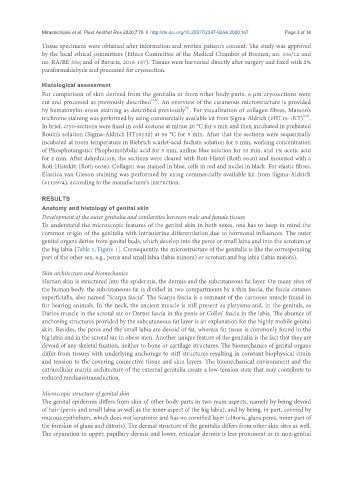Page 827 - Read Online
P. 827
Mirastschijski et al. Plast Aesthet Res 2020;7:70 I http://dx.doi.org/10.20517/2347-9264.2020.147 Page 3 of 14
Tissue specimens were obtained after information and written patient’s consent. The study was approved
by the local ethical committees (Ethics Committee of the Medical Chamber of Bremen, no. 336/12 and
no. RA/RE 336; and of Bavaria, 2018-157). Tissues were harvested directly after surgery and fixed with 2%
paraformaldehyde and processed for cryosection.
Histological assessment
For comparison of skin derived from the genitalia or from other body parts, 6 µm cryosections were
[5,6]
cut and processed as previously described . An overview of the cutaneous microstructure is provided
[5]
by hematoxylin-eosin staining as described previously . For visualization of collagen fibres, Masson’s
trichrome staining was performed by using commercially available kit from Sigma-Aldrich (#HT15-1KT) .
[6,7]
In brief, cryo-sections were fixed in cold acetone at minus 20 °C for 5 min and then incubated in preheated
Bouin’s solution (Sigma-Aldrich HT10132) at 56 °C for 5 min. After that the sections were sequentially
incubated at room temperature in Biebrich scarlet-acid fuchsin solution for 5 min, working concentration
of Phosphotungstic/ Phophomolybdic acid for 5 min, aniline blue solution for 10 min, and 1% acetic acid
for 2 min. After dehydration, the sections were cleared with Roti-Histol (Roth 6640) and mounted with a
Roti-Histokitt (Roth 6638). Collagen was stained in blue, cells in red and nuclei in black. For elastic fibres,
Elastica van Gieson staining was performed by using commercially available kit from Sigma-Aldrich
(#115974), according to the manufacturer’s instruction.
RESULTS
Anatomy and histology of genital skin
Development of the outer genitalia and similarities between male and female tissues
To understand the microscopic features of the genital skin in both sexes, one has to keep in mind the
common origin of the genitalia with intrauterine differentiation due to hormonal influences. The outer
genital organs derive from genital buds, which develop into the penis or small labia and into the scrotum or
the big labia [Table 1, Figure 1]. Consequently, the microstructure of the genitalia is like the corresponding
part of the other sex, e.g., penis and small labia (labia minora) or scrotum and big labia (labia majora).
Skin architecture and biomechanics
Human skin is structured into the epidermis, the dermis and the subcutaneous fat layer. On many sites of
the human body, the subcutaneous fat is divided in two compartments by a thin fascia, the fascia cutanea
superficialis, also named “Scarpa fascia”. The Scarpa fascia is a remnant of the carnosus muscle found in
fur bearing animals. In the neck, the ancient muscle is still present as platysma and, in the genitals, as
Dartos muscle in the scrotal sac or Dartos fascia in the penis or Colles’ fascia in the labia. The absence of
anchoring structures provided by the subcutaneous fat layer is an explanation for the highly mobile genital
skin. Besides, the penis and the small labia are devoid of fat, whereas fat tissue is commonly found in the
big labia and in the scrotal sac in obese men. Another unique feature of the genitalia is the fact that they are
devoid of any skeletal fixation, neither to bone or cartilage structures. The biomechanics of genital organs
differ from tissues with underlying anchorage to stiff structures resulting in constant biophysical strain
and tension to the covering connective tissue and skin layers. The biomechanical environment and the
extracellular matrix architecture of the external genitalia create a low-tension state that may contribute to
reduced mechanotransduction.
Microscopic structure of genital skin
The genital epidermis differs from skin of other body parts in two main aspects, namely by being devoid
of hair (penis and small labia as well as the inner aspect of the big labia), and by being, in part, covered by
mucous epithelium, which does not keratinize and has no cornified layer (clitoris, glans penis, inner part of
the foreskin of glans and clitoris). The dermal structure of the genitalia differs from other skin sites as well.
The separation in upper, papillary dermis and lower, reticular dermis is less prominent as in non-genital

